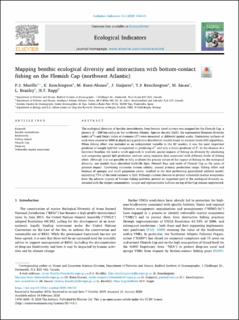| dc.contributor.author | Murillo, Francisco Javier | |
| dc.contributor.author | Kenchington, Ellen | |
| dc.contributor.author | Koen-Alonso, Mariano | |
| dc.contributor.author | Guijarro, J. | |
| dc.contributor.author | Kenchington, T.J. | |
| dc.contributor.author | Sacau, M. | |
| dc.contributor.author | Beazley, Lindsay | |
| dc.contributor.author | Rapp, Hans Tore | |
| dc.date.accessioned | 2021-08-05T07:59:57Z | |
| dc.date.available | 2021-08-05T07:59:57Z | |
| dc.date.created | 2021-01-18T12:14:57Z | |
| dc.date.issued | 2020 | |
| dc.identifier.issn | 1470-160X | |
| dc.identifier.uri | https://hdl.handle.net/11250/2766352 | |
| dc.description.abstract | The ecological diversity of benthic invertebrates from bottom trawl surveys was mapped for the Flemish Cap, a plateau of ~200 km radius in the northwest Atlantic. Species density (SpD), the exponential Shannon diversity index (eH′) and Heip’s index of evenness ( E ~') were measured at different spatial scales. Continuous surfaces of each were created to 2000 m depth using predictive distribution models based on random forest (RF) algorithms. When fishing effort was included as an independent variable in the RF models, it was the most important predictor of sample SpD but unimportant in predicting eH′ and only a minor predictor of E ~'. In the absence of a historical baseline, we used a novel approach to evaluate spatial impacts of fishing on diversity by simulating and comparing spatial SpD prediction surfaces using response data associated with different levels of fishing effort. Although it is not possible to fully evaluate the precise nature of the impact of fishing on the ecological diversity, our models have identified Sackville Spur, Flemish Pass and south of Flemish Cap as the areas of greatest impact. Combining minimum bottom salinity, annual primary production range, fishing effort and biomass of sponges and small gorgonian corals, resulted in the best performing generalized additive model, explaining 73% of the total variance in SpD. Although current closures to protect vulnerable marine ecosystems from the adverse impacts of bottom fishing activities protect an important part of the ecological diversity associated with the deeper communities, unique and representative habitats on top of the Cap remain unprotected. | en_US |
| dc.language.iso | eng | en_US |
| dc.publisher | Elsevier | en_US |
| dc.rights | Navngivelse 4.0 Internasjonal | * |
| dc.rights.uri | http://creativecommons.org/licenses/by/4.0/deed.no | * |
| dc.title | Mapping benthic ecological diversity and interactions with bottom-contact fishing on the Flemish Cap (northwest Atlantic) | en_US |
| dc.type | Journal article | en_US |
| dc.type | Peer reviewed | en_US |
| dc.description.version | publishedVersion | en_US |
| dc.rights.holder | Copyright 2020 The Authors | en_US |
| dc.source.articlenumber | 106135 | en_US |
| cristin.ispublished | true | |
| cristin.fulltext | original | |
| cristin.qualitycode | 1 | |
| dc.identifier.doi | 10.1016/j.ecolind.2020.106135 | |
| dc.identifier.cristin | 1873126 | |
| dc.source.journal | Ecological Indicators | en_US |
| dc.identifier.citation | Ecological Indicators. 2020, 112, 106135. | en_US |
| dc.source.volume | 112 | en_US |

